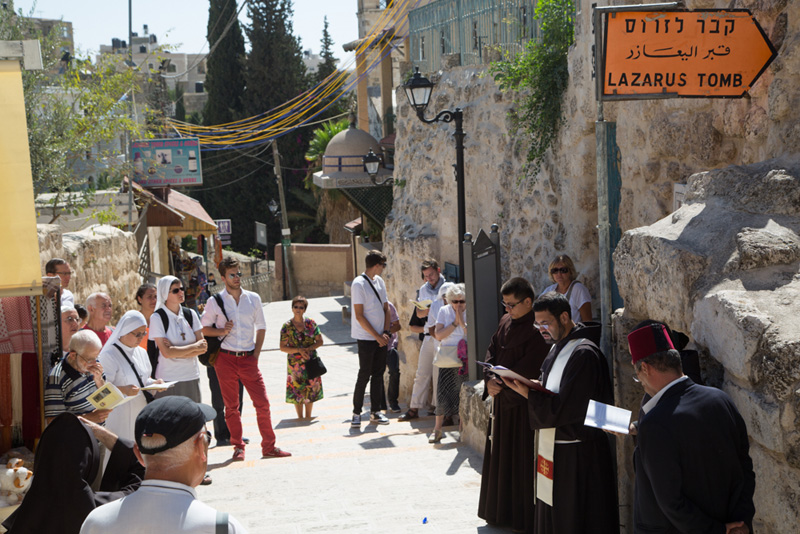
In the dead of summer, there is a small delegation of the Franciscans of the Custody who traveled to the tomb of Lazarus in Bethany on this day of the feast of Saints Martha, Mary and Lazarus.
The Secretary of the Custody, Br. Sergio Galdi, was the first to celebrate the 6:30 a.m. massat Lazarus’ tomb. The solemn mass at the sanctuary in Bethany actually began at 8 a.m., and it was presided over by the guardian of the holy place, Br. Michael Sarquah, who is as always very welcoming.
After the celebration and after a nice snack, the small congregation walked toward the entrance of the tomb of the saint in order to hear the Gospel of John’s narration of Lazarus’ resurrection.
After this,some of the faithful few visited the tomb itself. Small, handwritten notes have been placed throughout the tomb. The walls themselves are covered in graffiti, in which many names can be seen. And one of them is signed by a certain Pierre with “born again” written on it.
This is one of the lessons that we can learn from this place: that the Lord calls us to the life that only He can give.
But pilgrims could not get too lost in meditation because their charter buses were already waiting for them. In fact, it is customary to visit the Chapel of Ascension and then to go to the nearby Carmel chapel. The road used to be taken on foot. From Bethany to the Mount of Olives, a half-hour walk was all that it took. However, the road is blocked by a safety barrier, which requires a 20-kilometer detour; all the more reason not to miss the bus.
At the Chapel of the Ascension, after an entrance with the singing of the Te Deum, the reading ofJesus’ Ascension reminds us that the life He gives is so that we can be missionaries in the world. At the Church of the Pater Noster, the pilgrims commemorated the fact that the Lord Himself taught us to pray.
The congregation broke up, and some faithful chose to visit the garden with all of its mosaics, where the Our Father is written in a multitude of languages—nearly 200 of them—while others returned to their activities.
The next pilgrimage will take place on August 6. It traditionally brings together many more people, particularly the Palestinian Christian community from Galilee.
The Secretary of the Custody, Br. Sergio Galdi, was the first to celebrate the 6:30 a.m. massat Lazarus’ tomb. The solemn mass at the sanctuary in Bethany actually began at 8 a.m., and it was presided over by the guardian of the holy place, Br. Michael Sarquah, who is as always very welcoming.
After the celebration and after a nice snack, the small congregation walked toward the entrance of the tomb of the saint in order to hear the Gospel of John’s narration of Lazarus’ resurrection.
After this,some of the faithful few visited the tomb itself. Small, handwritten notes have been placed throughout the tomb. The walls themselves are covered in graffiti, in which many names can be seen. And one of them is signed by a certain Pierre with “born again” written on it.
This is one of the lessons that we can learn from this place: that the Lord calls us to the life that only He can give.
But pilgrims could not get too lost in meditation because their charter buses were already waiting for them. In fact, it is customary to visit the Chapel of Ascension and then to go to the nearby Carmel chapel. The road used to be taken on foot. From Bethany to the Mount of Olives, a half-hour walk was all that it took. However, the road is blocked by a safety barrier, which requires a 20-kilometer detour; all the more reason not to miss the bus.
At the Chapel of the Ascension, after an entrance with the singing of the Te Deum, the reading ofJesus’ Ascension reminds us that the life He gives is so that we can be missionaries in the world. At the Church of the Pater Noster, the pilgrims commemorated the fact that the Lord Himself taught us to pray.
The congregation broke up, and some faithful chose to visit the garden with all of its mosaics, where the Our Father is written in a multitude of languages—nearly 200 of them—while others returned to their activities.
The next pilgrimage will take place on August 6. It traditionally brings together many more people, particularly the Palestinian Christian community from Galilee.

